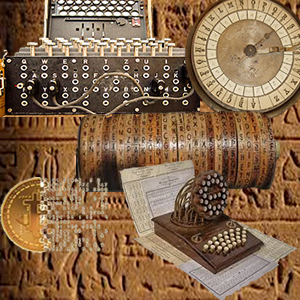Cyber Security:
 Cryptography
Cryptography
 Cryptography has been used throughout history. Julius Caesar used simple ciphers to send military orders to his generals, whereas more sophisticated medieval ciphers were used that withstood decryption until the late ninteenth century. More recently there is the famous Enigma codes of the Second World War.
Cryptography has been used throughout history. Julius Caesar used simple ciphers to send military orders to his generals, whereas more sophisticated medieval ciphers were used that withstood decryption until the late ninteenth century. More recently there is the famous Enigma codes of the Second World War.
Cryptography is underpinned by mathematics. Letters and numbers have to be manipulated in a reproducible way so that the message can be decrypted by the receiver - reversing the process. There are two types: symmetric and asymmetric.
The recent development of computers has allowed for far more complex means of encryption to be employed than was possible before.
Any data that can be represented in binary format, i.e. using 0s and 1s, can be encrypted by a computer.
Cryptography isn't just used to hide secrets, it can also be used to authenticate data sent on an insecure network – such as the internet. See hashing.
 Computers can:
Computers can:
 easily perform the necessary mathematical operations
easily perform the necessary mathematical operations
 employ more complex mathematics than could be reasonably expected of a human
employ more complex mathematics than could be reasonably expected of a human
 encrypt and decrypt at a much faster rate than a human
encrypt and decrypt at a much faster rate than a human
 handle complex and long messages - a large amount of data
handle complex and long messages - a large amount of data
 Common applications for cryptography include:
Common applications for cryptography include:
 secure banking and payments systems – cryptography ensures your money is safe when it is transferred between accounts, issued at ATMs or used to shop online
secure banking and payments systems – cryptography ensures your money is safe when it is transferred between accounts, issued at ATMs or used to shop online
 protecting privacy of conversations made over mobile telephones
protecting privacy of conversations made over mobile telephones
 safeguarding wireless networks that give access to the internet
safeguarding wireless networks that give access to the internet
 securing files on hard disks and memory sticks
securing files on hard disks and memory sticks
 authenticating electronic documents
authenticating electronic documents
 electronic voting
electronic voting
 securing media files such as music or movies from piracy, where it is known as Digital Rights Management (DRM).
securing media files such as music or movies from piracy, where it is known as Digital Rights Management (DRM).
 Terminology in cryptography
Terminology in cryptography
 plaintext – information that can be directly read by humans or a machine. Plaintext is a historic term pre-dating computers, when encryption was only used for hardcopy text, nowadays it is associated with many formats including music, movies and computer programs
plaintext – information that can be directly read by humans or a machine. Plaintext is a historic term pre-dating computers, when encryption was only used for hardcopy text, nowadays it is associated with many formats including music, movies and computer programs
 ciphertext – the encrypted data
ciphertext – the encrypted data
 a cipher – the mathematics (or algorithm) responsible for turning plaintext into ciphertext and reverting ciphertext to plaintext. It is sometimes called ‘code’ – there is a technical difference between the two but they are used interchangably except by experts.
a cipher – the mathematics (or algorithm) responsible for turning plaintext into ciphertext and reverting ciphertext to plaintext. It is sometimes called ‘code’ – there is a technical difference between the two but they are used interchangably except by experts.
 encryption – the process of converting plaintext to ciphertext (occasionally you may see it called ‘encipherment’).
encryption – the process of converting plaintext to ciphertext (occasionally you may see it called ‘encipherment’).
 decryption – the process of reverting ciphertext to plaintext (occasionally ‘decipherment’).
decryption – the process of reverting ciphertext to plaintext (occasionally ‘decipherment’).
 keys - pieces of information that determine the output from an encryption (or decryption) process.
keys - pieces of information that determine the output from an encryption (or decryption) process.
Pages related to this topic:
 Symmetric Cryptography
Symmetric Cryptography
 Asymmetric Cryptography
Asymmetric Cryptography
 Cryptography in Action
Cryptography in Action
 Cryptography Standards
Cryptography Standards

 Cryptography
Cryptography Cryptography has been used throughout history. Julius Caesar used simple
Cryptography has been used throughout history. Julius Caesar used simple 

